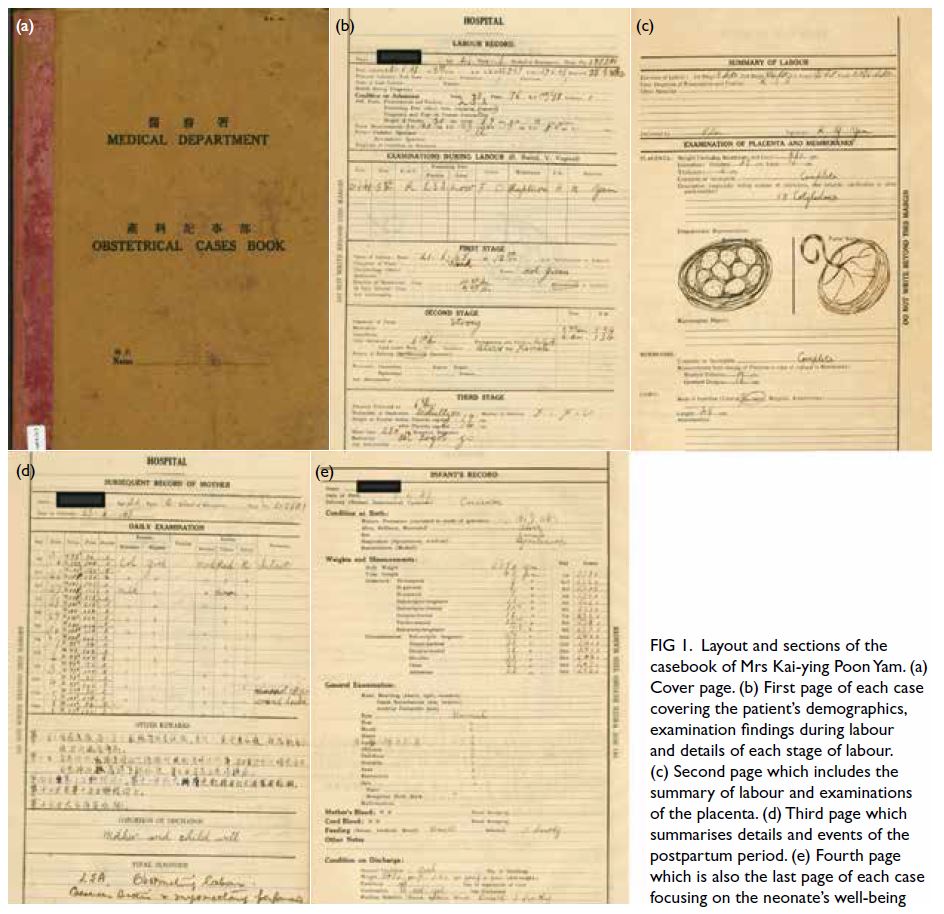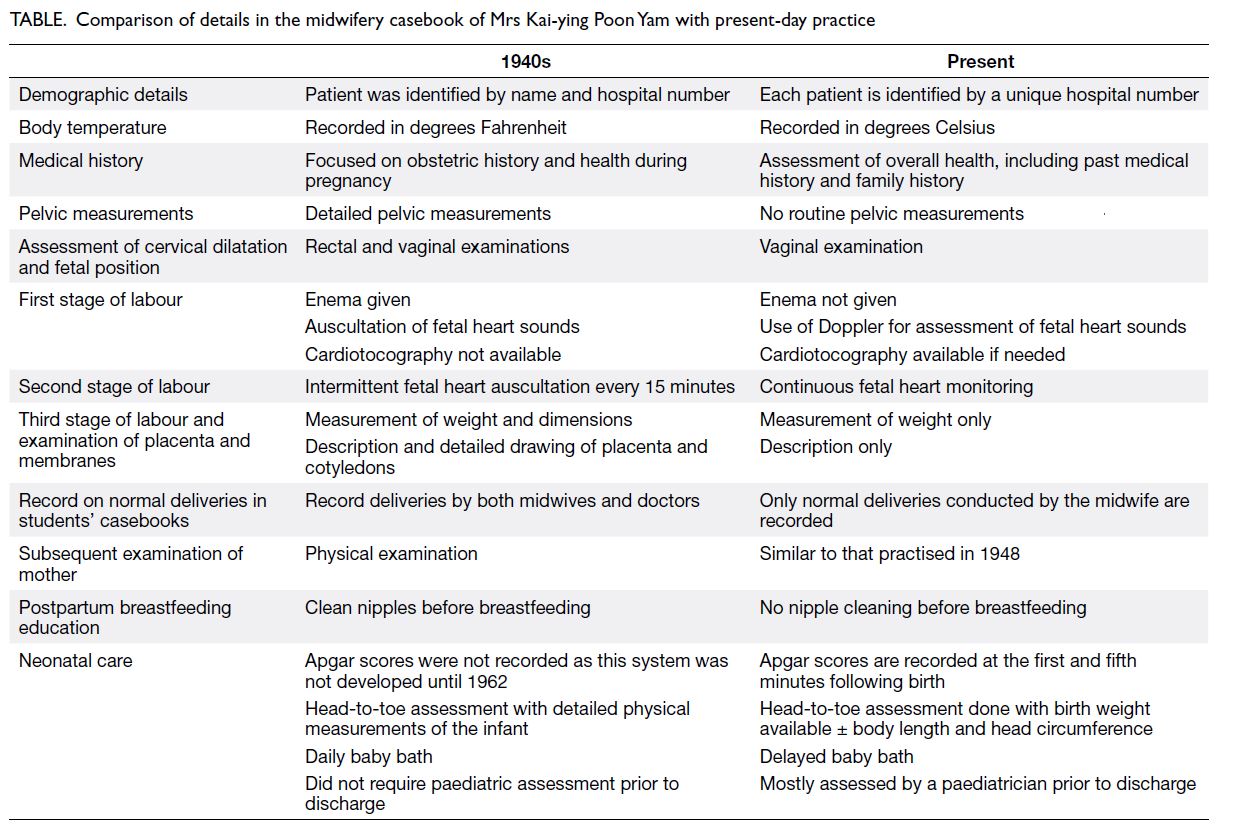© Hong Kong Academy of Medicine. CC BY-NC-ND 4.0
REMINISCENCE: ARTEFACTS FROM THE HONG KONG MUSEUM OF MEDICAL SCIENCES
Travelling back to the 1940s: inspirations from a midwifery casebook written between 1947 and 1948
Stephanie Adams, MD, MWomHMed1,2; CP Lee, FRCOG, FHKAM (Obstetrics and Gynaecology)1,3; Elce Au Yeung, MN, DN1,4; WC Leung, MD, FHKAM (Obstetrics and Gynaecology)1,2
1 Guest Authors, Education and Research Committee, Hong Kong Museum of Medical Sciences, Hong Kong SAR, China
2 Department of Obstetrics and Gynaecology, Kwong Wah Hospital, Hong Kong SAR, China
3 Department of Obstetrics and Gynaecology, Tsan Yuk Hospital, Hong Kong SAR, China
4 School of Midwifery, Department of Obstetrics and Gynaecology, Prince of Wales Hospital, Hong Kong SAR, China
The Hong Kong Museum of Medical Sciences was
honoured to receive the precious donation of a
casebook from a senior midwife, Mrs Kai-ying Poon Yam, who underwent midwifery training during
the 1940s in Hong Kong. Mrs Poon continued to
serve as a midwife until her retirement in 1978. The casebook contained detailed summaries of 30 births
that she participated in during her placement at Tsan
Yuk Hospital between 1947 and 1948 and provides
valuable insight into midwifery training in Hong
Kong during that time.
The Midwives Council of Hong Kong has
been responsible for the accreditation of midwifery
training since 1910.1 In order to qualify as a midwife,
students enrolled on to a 1- or 2-year training
programme depending on whether they were already
qualified nurses or not.2 Tsan Yuk Hospital began
delivering midwifery training in 1922 and the Tung
Wah Group of Hospitals joined shortly after.2
The birth rate in Hong Kong steadily increased
after the Second World War, leading to the ‘baby
boom’ era. At first, pregnant women preferred to
deliver at home or in a maternity home due to the
shortage of resources.2 However, in the 1950s,
attitudes changed due to the poor living conditions
and high risk of infections, making hospitals a more
popular choice.2 The concept of remaining in hospital
postpartum until stitches were removed was well
accepted by expectant mothers. As such, the period
when Mrs Poon (also known as Ms Kai-ying Yam
when she was a student midwife) underwent her
training was a very interesting time to observe the
rapid development and transformation of obstetric
care in Hong Kong.
During her training at Tsan Yuk Hospital, Mrs
Poon participated in 513 normal deliveries and 84
abnormal deliveries and she recorded 30 in detail in
her casebook. Of these cases, 24 were spontaneous
vaginal deliveries, three were instrumental deliveries,
two were by caesarean section, and one required
interval version. Of note, both caesarean sections were
performed by Prof Gordon King, who was the head
of the Department of Obstetrics and Gynaecology
of The University of Hong Kong.3 Three babies
unfortunately died. Each case was recorded on four A4-sized pages and included demographical details,
examination findings, details of the various stages of
labour, findings from examination of the placenta,
postpartum progress, and neonatal measurements
and progress (Figs 1 and 2). Although the content
of each record indicates that many practices were
largely similar to those used today, there are some
differences which demonstrate a different focus of
care and changes in patient management. The Table
summarises the differences between the content of
the casebook and present-day obstetric practice.

Figure 1. Layout and sections of the casebook of Mrs Kai-ying Poon Yam. (a) Cover page. (b) First page of each case covering the patient’s demographics, examination findings during labour and details of each stage of labour. (c) Second page which includes the summary of labour and examinations of the placenta. (d) Third page which summarises details and events of the postpartum period. (e) Fourth page which is also the last page of each case focusing on the neonate’s well-being

Figure 2. Drawings in the casebook of Mrs Kai-ying Poon Yam demonstrating examination findings of the placenta. (a) A normal placenta. (b) A placenta with marginal placenta previa

Table. Comparison of details in the midwifery casebook of Mrs Kai-ying Poon Yam with present-day practice
Tsan Yuk Hospital was one of the key providers
of maternity services in the 1940s. In 1948 alone,
Tsan Yuk Hospital managed 4830 admissions in
which 4577 babies were delivered.4 Most patients
delivered vaginally, with 88 instrumental deliveries
and only 28 caesarean sections.4 Seventy early
neonatal deaths and two maternal deaths were
recorded.4 These numbers are impressive and likely
the result of high standards of professional practice
by both doctors and midwifes like Mrs Poon. As a
midwifery student at Tsan Yuk Hospital in 1948, Mrs
Poon was not only an invaluable frontline member of
staff but she also made a significant contribution to
the development of maternity care in Hong Kong.
Through the casebook, Mrs Poon presents
as a model student midwife, demonstrating
her professionalism and skill in practising the
art and science of midwifery. The casebook is
also comprehensive enough to reflect the high
standards of midwifery training at that time. Today,
all student midwives are assigned designated
mentors who provide individual guidance during
placements and every clinical experience log must
be countersigned by the supervising midwife. The
element of supervision which Mrs Poon would
have received cannot be gauged merely by reading
the casebook, but it would be interesting to know
the degree of independence and coaching provided to student midwifes at that time. Although she
practised midwifery before technologies such as
cardiotocography were available and the advent of active midwifery research, Mrs Poon’s records
demonstrate a holistic approach and remarkable
continuity of care for the women and their babies.
References
1. The Midwives Registration Ordinance (Cap 162 of Laws of Hong Kong). 1960 Dec 9.
2. Chow AW. Metamorphosis of Hong Kong midwifery. Hong Kong J Gynaecol Obstet Midwifery 2000;1:72-80.
3. Department of Obstetrics and Gynaecology, The University of Hong Kong. About the department. 2023. Available from: https://obsgyn.med.hku.hk/en/About-Us/About-The-Department. Accessed 18 Nov 2023.
4. Tsan Yuk Hospital. Labour and Delivery Log, 1948.

